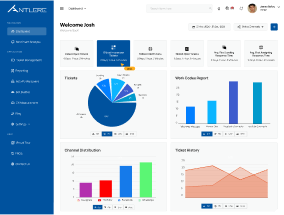What is the Difference Between a Hot Call and a Cold Call?
In the world of sales and marketing, first impressions matter. And often, the first impression is made not in person, but over the phone. If you’re building a sales strategy, you’ve probably come across terms like “cold call,” “warm call,” and “hot call.” But what is the difference between a hot call and a cold call? And how do these approaches impact your results?
In this article, we will explain the difference between cold calling, warm calling, and hot calling and when and how you should use them. In this article, we’ll outline what cold calling is, get into warm calling meaning with a full breakdown of both essential sales tools.
What is a Cold Call?
Let us begin with the simplest of questions: what is a cold call?
A cold call is an unsolicited phone call made by a salesperson to a potential customer who has had no prior interaction or expressed interest. In short, you’re calling someone “cold” without any established relationship.
Cold Call Meaning:
- What is cold calling? Reaching out to prospects who haven’t interacted with your brand.
- Cold calls meaning: Contacting a lead out of the blue, often using contact lists, databases, or CRM systems.
- What does cold calling mean? This means putting a sales trigger into action with a prospect who has not previously interacted with your business.
- Cold caller meaning: A salesperson who reaches out to prospects via cold calls.
- Define cold call: An attempt to sell a product or service to someone who has not shown previous interest.

Though cold calling is considered old-fashioned or intrusive, it still has a place in many outbound sales approaches. In fact, 82% of those buyers are willing to take meetings with a seller that reaches out first, and cold calling can boost conversion USPs up to 50% when proper strategies are deployed.
What is Warm Calling?
In technical terms, warm calling means a prospect had one interaction or more with your brand, whether that was visiting your website, downloading a resource or social media engagement.
Warm Calling Meaning:
- What is warm calling? It means contacting leads who are somewhat familiar with your brand.
- Warm call: A sales call made to someone who has been partially qualified or expressed mild interest.

Warm calls typically occur after a digital touchpoint, email campaign, or inbound inquiry. Because there’s already some level of familiarity, warm calls have a higher success rate than cold calls.
HubSpot reports that warm leads convert 2–3 times better than cold leads.
What is a Hot Call?
A hot call is a sales call you make to a hot lead who is otherwise known as a hot prospect or a hot lead, and this person is someone who is ready to make a purchase or has shown a high level of interest in your offering. Such leads are also known as sales-qualified leads (SQLs).
Examples include:
- Someone who has filled out a pricing form
- A user who has signed up for a product demo
- A returning customer who expressed interest in an upsell
Hot calls are the most valuable and time-sensitive. These contacts are actively seeking solutions and are often comparing vendors.
Table: Cold Calling vs Warm Calling vs Hot Calling
Factor | Cold Calling | Warm Calling | Hot Calling |
Relationship | No prior interaction | Some prior engagement | Actively interested |
Conversion Potential | Low to Medium | Medium to High | Very High |
Risk of Rejection | High | Moderate | Low |
Caller Preparation | High research needed | Moderate research | Minimal (buyer is informed) |
Typical Goal | Start a conversation | Build a relationship | Close the sale |
Response Time Needed | Low urgency | Medium urgency | High urgency |
Cold Calling vs Warm Calling: Which is Better?
Cold calling vs warm calling – neither is better than the other, really: it depends on your target audience and on your objective.
Cold calls are great for:
- Building brand awareness
- Breaking into new markets
- Expanding reach at the top of the funnel
Warm calls are ideal for:
- Following up on lead magnets or webinars
- Re-engaging past contacts
- Moving prospects through the middle of the funnel
A successful sales pipeline uses both, along with hot calls to close.
Common Myths About Cold Calls
Cold calling has a poor reputation, although it is such a common practice. Let’s debunk some common misconceptions:
- “Cold calling is dead” — Not true. Modern cold calling backed by data and personalization is highly effective.
- “Buyers hate cold calls” — Research shows 57% of C-level buyers prefer phone contact over email.
- “Only junior reps cold call” — Cold calling is a skill that even senior salespeople refine and use strategically.
Tips for Better Cold and Warm Calling
Whether you’re cold calling or warm calling, here are a few tips to improve performance:
- Do Your Research: Learn about the industry, company, and decision-maker.
- Personalize the Pitch: Mention relevant pain points or past interactions.
- Time it Right: Midweek and mid-morning are statistically best.
- Use Scripts Wisely: Have a structure, but don’t sound robotic.
- Follow Up: Persistence increases reply rates by 80%.

Cold Calling Services: When to Outsource
To spread the word further, businesses frequently bring on a cold calling service in-house or bring someone that specializes in cold calling. This is useful when you:
- Lack internal bandwidth
- Need to qualify large lead lists
- Are entering new geographic markets
Cold Calls are Always Better Outsourced so You Can Close and Manage Accounts with Internal Teams.
Conclusion
So, what is the difference between a hot call and a cold call? Timing, relationship and buying intent – that’s the whole round thing in a nutshell.
- Cold calls are the first contact, requiring persistence and patience.
- Warm calls leverage existing touchpoints to build momentum.
- Hot calls target leads who are ready to buy and require a closer.
So, what’s the difference between a hot call and a cold call? It comes down to timing, relationship, and buying intent.
Cold calls are the first contact, requiring patience. Warm calls build on existing touchpoints. Hot calls focus on leads ready to buy.
At Abacus Outsourcing, we specialize in handling all types of calls with the right approach. By combining smart outreach strategies with expert execution, we help you maximize every conversion opportunity.
Choosing the Right BPO Partner in Pakistan – A US Buyer’s Checklist
With a competitive world market and the modern business process, the outsourcing is not primarily a cost-saving strategy; it is now a growth strategy.
Finding the right BPO partner in USA can result in increased efficiencies, improved customer services and also access to the global talent pool for many U.S. businesses.
To start off into the checklist, it is important to clarify some terms. BPO is known as Business Process Outsourcing, which means that a business can outsource particular business tasks to various BPO service providers.
This might be customer care, bookkeeping, data entry or even more technical services. When it comes to what is BPO in business (or what is a BPO business) it is simply the strategic outsourcing of operational practices to specialists who in many cases have greater efficiencies and cost-effectiveness of doing it.
Why Pakistan Is an Attractive Destination for US Companies
When you are a BPO partner in USA outsourcing allows you to ensure your operations run smoothly while meeting global standards.
Pakistan is rapidly emerging as a key hub in the global BPO industry. The country offers a large pool of skilled, English-speaking professionals, competitive labor costs, and an ever-improving technology infrastructure.
BPO companies in Pakistan uphold quality standards that often surpass those of more traditional outsourcing destinations.
To American businesses, outsourcing to Pakistani BPO providers is a great cost effective strategy.
The time zone of Pakistan also supports U.S. operations, enabling 24/7 business continuity. This overlap allows faster turnaround times and uninterrupted operations.
Buyer Checklist For US in Selecting the Appropriate Partner
Choosing the right BPO partner in USA requires more than simply scanning a list of providers. You will have to probe further so as to be assured that the partnership will give you the desired outcome. A full checklist is as follows:
Know Your Goals and Objectives
Clearly state what you intend to achieve through BPO outsourcing – whether to cut costs, enhance customer experience, grow faster, or all of the above. Be clear on the services you require, whether customer care or back-office functions.
image
Evaluate Industrial Experience
The business you choose must have experience in your sector. One should look for client testimonials, case studies, and a track record. Top-tier business process outsourcing firms frequently have industry-specific teams who are familiar with sector requirements. A reliable BPO service not only handles your tasks efficiently but also aligns with your long-term business strategy.
Establish Cultural Fit and Communication Skill
Communication skills, English fluency, and customer focus are essential. A trusted BPO partner in USA can become an extension of one’s own team, which will drive both efficiency and growth.
Availability and Time Zone
Ensure your provider offers the coverage you need – whether around-the-clock or after-hours support.
Legal and Data Security Compliance
Ask potential BPO solutions integrators about compliance with local labor laws, data protection and worldwide laws. Outsourcing of business processes requires safe handling of the data, which is not subject to negotiation.
Pricing Transparency
The best BPO business process outsourcing providers lead with costs. Be sure there is no hidden cost and that the pricing structure is favorable for your business. Ability to scale services up or down with flexibility is an added advantage.
Recruitment and Onboarding Process
Find out how the BPO company recruits, trains, and integrates staff. A smooth onboarding process allows productivity from the first day. Leading BPOs often provide post-hire support and performance guarantees.
Scalability
Your chosen BPO partner should have the ability to quickly scale resources in response to changing business need. Real scalability equates to being able to scale your operations to reflect the real requirements of the business, being always nimble and efficient and able to adapt to business changes that arise in the market.
image
Technology and Tools
Gather all relevant information about operations, infrastructure, communication platforms etc. The appropriate systems will provide transparency and real-time updates. The quality of a BPO service often determines how well your brand delivers on its customer promises.
Performance Measurement
A good BPO outsourcing company will report and check the performance indicators regularly. This will aid in achieving accountability and constant development.
The Advantages of Sourcing from Pakistan
In case you choose Pakistan based BPO partner in USA, you are exposing yourself to a market that offers competitive prices, top quality services as well as an enormous pool of skilled labour.
When selecting a BPO partner in USA, prioritize alignment with your company’s vision and customer expectations.
The majority of business process outsourcing companies in Pakistan operates on international standards of quality and delivers specialist skills.
This makes the country a good target to venture in search of reliable BPO solutions by either small or large business.
Pakistan is also host to large numbers of service providers in all fields including financial and health to technical support and e-commerce.
With such diversity, the U.S. firms will be able to find a counterpart in the BPO outsourcing firms with direct company requirements in mind.
Cold, warm, or hot – Abacus BPO listens, adapts, and delivers value at every stage.










